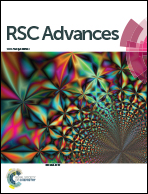Volume phase transition of electron beam cross-linked thermo-responsive PVME nanogels in the presence and absence of nanoparticles: with a view toward rheology and interactions†
Abstract
We investigate the effect of nanoparticles and radiation dose on interactions in the PVME-based nanogel system and its phase behavior (swelling/deswelling behavior and phase separation mechanism) by rheological and FTIR measurements. The volume phase transition temperature of pure and hybrid nanogels are obtained by an isochronal temperature sweep test. Phase contrast optical microscopy is employed to investigate morphological evaluation. It is found that frustrating the mobility of polymer chains in nanogels by the addition of nanosilica or increasing the radiation dose increases the deswelling temperature, and also slows down the kinetics of phase separation. The enhanced dynamic asymmetry in the presence of nanoparticles leads to transition of the phase separation mechanism from nucleation and growth (NG) to viscoelastic phase separation (VPS). We investigate the linear and transient rheological behaviors of pure and hybrid nanogels synthesized with different radiation doses in the homogenous and phase-separated regions. Finally, the conformity of the prediction of emulsion models and rheological behavior of phase-separated nanogels is investigated.


 Please wait while we load your content...
Please wait while we load your content...